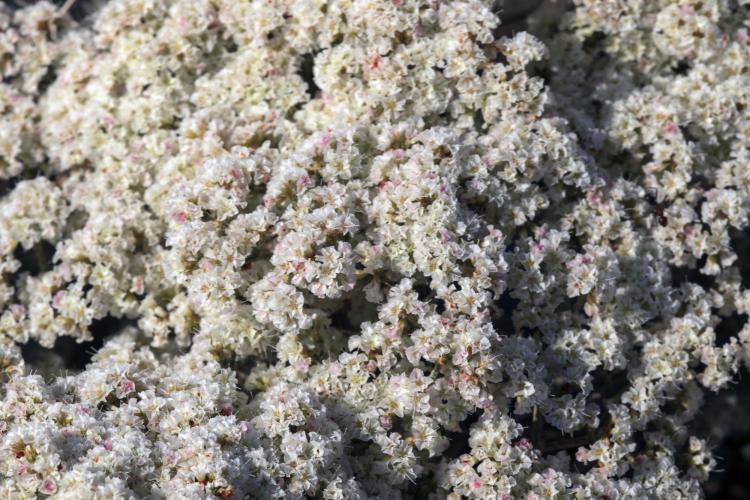Fremont’s buckwheat supports a community of users
Bumping down a dirt road on the San Rafael Swell, near an area named Jackass Benches, I hoped to find the burros that I had seen earlier this year. Some burros would have traced their lineages back to those that escaped from traders and settlers traveling on the Spanish Trail, but more would have descended from burros that miners set free as uranium mines shut down. The burros eluded me, but I was delighted to find a cluster of large wildflowers in bloom in an otherwise-parched landscape.
Approximately a dozen Fremont’s buckwheats, Eriogonum corymbosum, occupied the shallow and wide bed of an ephemeral stream. The largest was a globe, three feet in diameter, of densely packed flower heads, each composed of many small white flowers. Sepals (look like petals) are white when young, but develop pink hues as the flowers age.

At the top of the page: A Fremont’s buckwheat grows in the shallow bed of an ephemeral stream on the San Rafael Swell. Above: Early blooms on the plants are white. Photos by Jeff Mitton
The west has many buckwheats, for Eriogonum is the second largest genus (Penstemon is the largest) endemic to North America, with about 230 species. I had previously been familiar with two other buckwheats, sulphur-flowered buckwheat, E. umbellatum, which is common in the foothills of the Front Range, and the bizarre desert trumpet, E. inflatum, locally abundant in warmer and drier sandy sites on the Colorado Plateau.
E. corymbosum is really a descriptive name. A corymb is the slightly rounded flower formation, distinctive in that each flower’s stem has a separate attachment to the main stem. “Osum” is from the Latin, meaning “full of,” indicating that E. corymbosum is full of corymbs.
John Fremont made the first scientific collection of this species in 1845 near Eagle. Fremont was a famous explorer and collector (and general, governor and senator) who sent his collections to professional botanists. Professors John Torrey (Princeton, Columbia) and Asa Gray (Harvard) named 163 new species from his collections. Forty plant species bear his name (fremontii), as does Colorado’s Fremont County and the Fremont River, which flows through Capitol Reef National Park.
Native Americans knew Fremont’s buckwheat long before Fremont collected it, for they used it to make tea, treat coughs and tuberculosis and to make several foods. The Hopi boiled the stalks, pressed them into cakes and ate them with salt. They also ground the leaves into a meal that was mixed with cornmeal and water and baked to make bread. I did not find that Navajo used E. corymbosum, but 28 species of Eriogonum are found on the Navajo Nation, and many were sources of food or medicine.
In addition to serving many Native Americans, Fremont’s buckwheat is also the preferred host plant for oviposition and larval feeding of several species of butterflies. The caterpillars of Sheridan’s hairstreak, Callophrys sheridanii, and Mormon metalmark, Apodemia mormo, feed on buckwheat leaves. Ellis’ dotted blue caterpillars, Euphilotes ellisii, feed on buckwheat flowers.
When I was photographing buckwheat flowers I came across a caterpillar, about two inches long, eating flowers. Its body had a black background with light blue bands that were not simple rings, but had horseshoe shapes on the dorsal side. Clusters of hairs and spines arose from rusty orange buds or mounds that also circled the body. Long, flexible hairs were probably tactile, and shorter, straight stiff spines, either white or black, looked defensive.
I took several photos of it and sent them to several experts, but they did not come to agreement about either the species identification or even its genus. Everybody enjoys a puzzle! Next year I will return to Jackass Benches to collect some caterpillars for genetic analyses to resolve whether this was just an unusual specimen or an undescribed species.
Biologists initially thought the distribution of Fremont’s buckwheat was determined by a requirement for gypsum in the surface soils. A careful study of surface soils and distribution of the buckwheat has shown the buckwheat is tolerant of gypsum, but it does not require it.
Fremont’s buckwheat is native to dry areas of the southwest, or more specifically, Wyoming, Nevada, Utah, Colorado, Arizona and New Mexico. But within its geographic range, variation in genetics, flower color, plant shape and branching pattern are differentiated among contrasting habitats, suggesting that this buckwheat has adapted to different environments. Eight of these are sufficiently distinct to have names identifying them as subspecies.
I look forward to returning next year to sample the pretty but unusual caterpillar and to look for other populations of these large globes of flowers called buckwheats. Naturalists tend to be inquisitive in natural environments, and I want to know more about Fremont’s buckwheat and the community of herbivores and pollinators that it supports.

